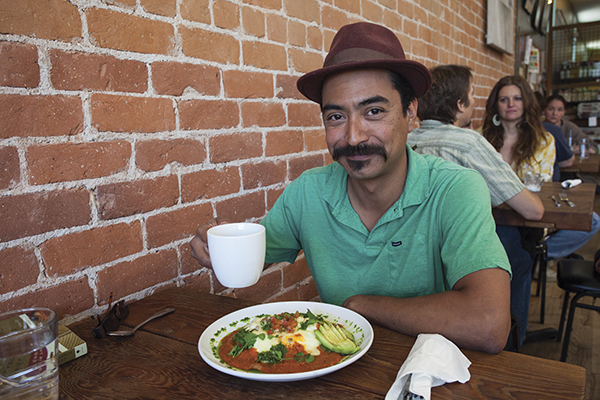
5 Points Market & Restaurant. Photo by Andrew Brown.
12 Essential Spots to Brunch It Up, and Then Some.
Whoever came up with the idea to combine breakfast, lunch and champagne into one meal is my hero.
Brunch is the best of both worlds: sweet and savory, breakfast and lunch, mimosas and Bloody Marys. There’s something to please just about everyone. Brunch is the socially acceptable way to enjoy breakfast foods after 10 a.m. and alcohol before noon.
The History of Brunch
The word “brunch,” states its Wikipedia entry, “is a portmanteau of the words ‘breakfast’ and ‘lunch.’ The term was coined in Britain in 1895” by writer Guy Beringer; the entry continues, “to describe a Sunday meal for ‘Saturday-night carousers’.”
A 1998 New York Times article by William Grimes, sited in the Wikipedia entry, says, “Brunch eliminated the need to wake up early, leaving everyone in a much better mood.” According to this article, Beringer stated that brunch “is talk-compelling. It puts you in a good temper, it makes you satisfied with yourself and your fellow beings, it sweeps away the worries and cobwebs of the week.”
After weekend festivities or early morning hunts in the nineteenth century, the wealthy would gather for this late morning meal. The richer the British Empire grew, the more popular brunch became. The meal grew to eventually resemble the meal we are familiar with today, accompanied by more complicated dishes and everything placed on the table at once.
Beginning in the 1920s, brunch began picking up speed in the U.S. as restaurants and customers alike realized the potential greatness of this mid-morning meal. The popularity of brunch is now world-wide and available in almost any ethnic cuisine. Brunch is exceedingly popular in Tucson as well. Our beautiful climate affords us the luxury of dining al fresco almost all year ‘round which further enhances the leisurely enjoyment of good company and good food.
We invite you to try one of the twelve delightful spots we’ve listed for you after you’ve slept in. Kick off the covers, bring your copy of Zócalo or the New York Times and linger over coffee and conversation at any one of these eateries, in no particular order:
1. Ghini’s French Caffe
1803 E. Prince Rd. (520) 326-9095 , GhinisCafe.com
Why We Love It: Ghini’s serves breakfast all day and offers a gluten-free menu on Sundays. Ghini’s celebrates its 18th year as a locally owned Tucson business this July.
Why Tucson Loves It: Ghini’s outdoor seating is dog-friendly and servers will bring water and a biscuit to Fido. Adjoining Ghini’s is their La Baguette Bakery. La Baguette is a full service French bakery which has amazing bread and tempting pastries.
Atmosphere? Ghini’s has patio seating outdoors and smallish tables indoors. Can become crowded on Sundays and you may have a waiting list.
To Try: Ghini’s French cuisine includes their signature dish, Eggs Provençal, which is rich, buttery and laden with plenty of garlic. Of course, there are freshly prepared crepes, croissants and fresh-squeezed Mimosas to sip.
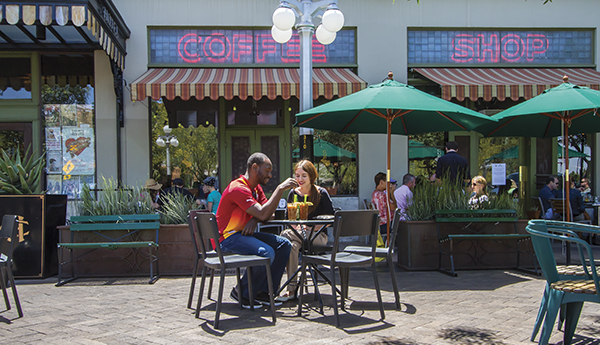
Brunch at The Cup Cafe at Hotel Congress. Photo by David Olsen
2. The Cup Café at Hotel Congress
311 E. Congress St. (520) 798-1618, HotelCongress.com
Insider Tip: The Build Your Own Bloody Mary Bar. You can go crazy with capers, horseradish, cucumber, or bleu cheese with the house blend Bloody Mary mix. Not feeling Bloody? The Cup Café serves classic mimosas, Bellinis and yes, a breakfast margarita!
Why Tucson Loves It: It’s Downtown! Breakfast is served all day. The Cup has lovely outdoor patio seating that faces north so you don’t roast if you choose to sit outside, and it is dog-friendly. The shared space with Hotel Congress makes The Cup popular for live music and people-watching. With its proximity to The Rialto Theatre, celebrities are often spotted at Hotel Congress and at The Cup.
What to Try? Definitely try the Cast Iron Baked Eggs with leeks, Gruyere, cream and ham. Or if you’re really famished after a night of revelry, try the Braveheart. With smoked beef brisket on sourdough toast, sauteed spinach, and Gruyere cheese topped with poached eggs and creamy sausage gravy, this creation is sure to satisfy a hearty appetite.
When To Go: The breakfast menu is served from 7 a.m. to 4 p.m. When our weather is fine, the outdoor patio may be full, but there is comfortable seating indoors as well.
3. 47 Scott
47 N. Scott Ave. (520) 624-4747, 47Scott.com
Why We Love It: 47 Scott is a Downtown spot with one of the most intriguing bar menus in town. The master mixologists are celebrated for their unusual and creative concoctions like “3 Hours to Launch” and “The Dancehall Queen” as well as fanciful mimosas and Bellinis.
You Must Try: Modern comfort food menu offering menu items like Frisee and Bacon Salad topped with a perfectly poached egg. The Mussels and Pomme Frites are made for sharing, with mussels and Andouille sausage steamed in white wine and Kennebec potato fries hot and crisped in peanut oil.
The Vibe: Casual and sophisticated bistro atmosphere with a full bar and large outdoor brick patio. Menus are changed seasonally.
Hit It Up: Reservations are suggested and brunch is served each Sunday from 10 a.m. to 4 p.m.
4. The Grill at Hacienda Del Sol
5501 N. Hacienda Del Sol Rd., (520) 529-3500, Haciendadelsol.com
What We Love: The Grill features locally and regionally sourced meats, vegetables and herbs grown in the restaurant’s garden and house made cheeses. The Grill offers al fresco dining on their lovely patio and has an extensive wine list.
The Ambiance: Quiet and elegant with top-notch service. The gorgeous, panoramic Santa Catalina Mountain vistas make The Grill at Hacienda Del Sol perfect place to brunch and impress out of town guests.
Hit It Up: Brunch is served every Sunday from 9:30 a.m. to 2 p.m. Complimentary champagne is served as you peruse the fresh and bountiful buffet and carving stations. Reservations are suggested.
5. Prep and Pastry
3073 N. Campbell Ave. (520) 326-7737, PrepandPastry.com
Why We Love it: Locally sourced food and the delicious varieties of homemade hash. Sweet Potato Hash and Duck Confit Hash are brunch menu favorites.
Why Tucson Loves It: PASTRIES! One of the most popular at Prep and Pastry is the maple-bacon “cronut.” A hybrid of a donut and croissant, this crispy/chewy/flaky pastry is topped with a delectable maple glaze and crumbled bacon. It’s perfectly okay to lick your fingers afterward.
The Atmosphere: Once the home of Amelia Grey’s Tea Room, the quaint and charming indoor decor invites one to linger for a lazy weekend brunch. The outdoor dog-friendly patio is a popular perch as well. Be prepared for a waiting list and a bit of a wait, but it will be worth it.
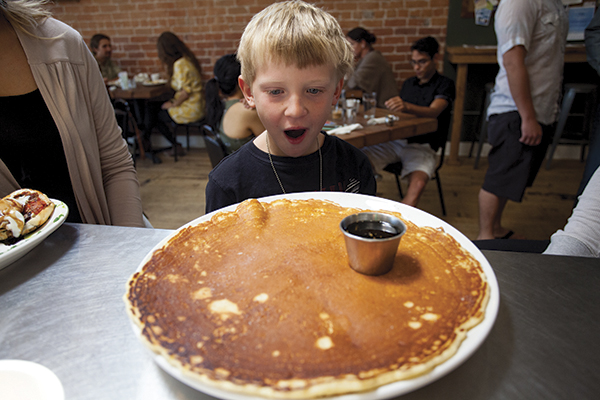
5 Points. Photo by Andrew Brown.
6. 5 Points Market & Restaurant
756 S. Stone Ave. (520) 623-3888, 5PointsTucson.com
The Vibe: 5 Points Market & Restaurant can be described as having a hipster and casual, yet familial atmosphere. The restaurant is open daily from 7 a.m. to 9 p.m.
What To Eat: Huevos Rancheros! Best in Tucson. If you’d like something lighter, try the Breakfast Salad. The portions are large, so come hungry.
Insider Tip: 5 Points Market is a gourmet delight if you love to cook. The market is similar to Whole Foods with fresh produce and meats and features vegan and raw food products as well as gluten free items.
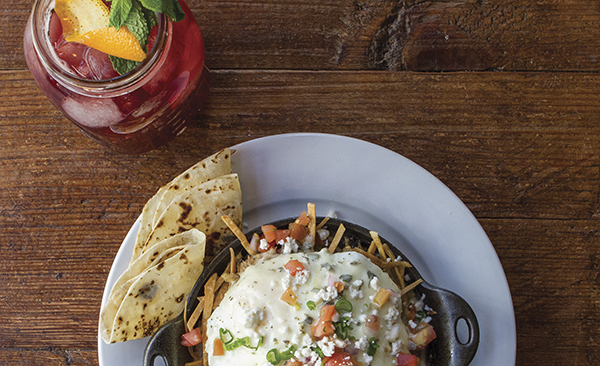
Brunch at Penca. Photo by David Olsen.
7. Penca
50 E. Broadway Blvd. (520) 203-7681, PencaRestaurante.com
Why Tucson Loves It: Penca is housed in a revitalized historic building in the heart of Downtown Tucson. The 1920s building has been lovingly restored with reclaimed building materials from other historic locations. The colorful earthenware dishes are from Tucson’s own Santa Theresa Tile Works. Reservations can be made online.
The Vibe: Urban cool blended with Southwestern simplicity. Warm and intimate in feel. The proprietors love to have a personal relationship with their patrons and are excited to have “regulars” who frequent the restaurant.
The Food: Mexico City style cuisine lovingly prepared with locally sourced produce and meats. Penca has a very innovative bar menu serving Pechuga Mezcal and other Southwestern inspired spirits, like top-shelf varieties of tequila. Sample the Chile en Nogado entree which succulent pork braised in chile poblano with apples, plantains, dried fruit and almonds. Saboroso!
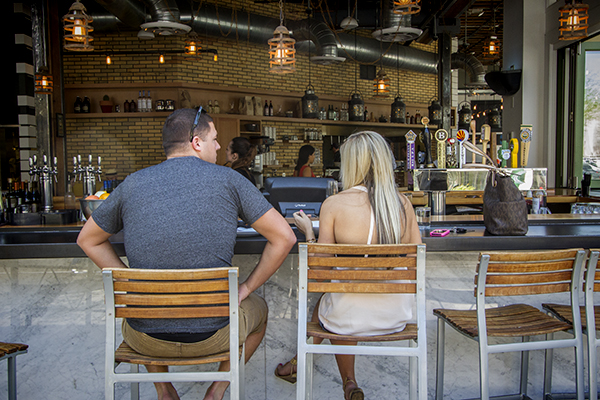
Outdoor seating at Proper.
8. Proper
300 E. Congress St. (520) 396-3357, ProperTucson.com
Why We Like It: The mixologists at Proper mix a killer cosmopolitan and a perfectly dry martini. Most importantly is that Proper proudly serves locally sourced food featuring artisanal charcuterie, cheeses and bread. Proper is committed to the concept of “farm to table” eating and any of the menu items can be prepared gluten-free.
The Atmosphere: Sophisticated indoor dining area with great views of Downtown traffic for people watching, as well as patio space for you to linger with cocktails.
Must-Order: Proper puts their fresh and signature spin on steak and eggs. The eggs are hormone-free from free-range chickens, prepared to order with locally sourced tender steak, a cheesy gratin of leeks and a zesty chimichurri sauce.
9. Cafe a la C’art
150 N. Main Ave. (520) 628-8533, CafeaLaCartTucson.com
Why Tucson Loves It: Cafe a La C’art has been in business for 18 years and is ensconced in the courtyard of the Tucson Museum of Art in the historic Stephens/Duffield House.
Pay A Visit: The cafe serves breakfast and lunch from 8 a.m. to 3 p.m. on Saturdays and Sundays. The pause that refreshes before or after your visit to the Tucson Museum of Art.
What’s Cooking? Try the satisfying Cafe Skillet with rosemary roasted potatoes, topped with eggs any style, bacon and cheddar and jack cheeses.
10. La Cocina
201 N. Court Ave. (520) 622-0351, LaCocinaTucson.com
Why Tucson Loves It: La Cocina is popular with Downtown’s denizens for the live music, theme parties, signature cocktails and an inexpensive menu. La Cocina offers lovely al fresco seating in the beautiful hacienda patio of Old Town Artisans with tables to accommodate two or ten.
What’s On The Menu? Mexican breakfast favorites like chilaquiles: fresh corn tortillas simmered in red or green sauce and a roasted pepper and onion mix. Topped with cheese and two eggs cooked to order. Served with a side of beans and a small garden salad. Another delectable brunch entree to savor is La Cocina Niçoise featuring house smoked salmon, arugula, hard boiled egg, red potato, roasted vegetables, Parmesan, and a tangy mustard vinaigrette.
11. Nox Kitchen & Cocktails
6370 N. Campbell Ave. (520) 529-5849, NoxTucson.com
New! Upscale Hemingway-themed casual decor with patio seating and lots of TV screens. Opened two months ago and features a newly implemented Sunday brunch menu. Perfect place to catch your favorite weekend sporting event.
The Ambiance: Patrons report that Nox plays fantastic music playlists from Spotify and Pandora enhancing the fun, hip atmosphere.
The Food: Shareable Duck Confit Fries are a popular nosh at Nox. Equally delicious is the Nox French Toast encrusted with fruit and nuts. The brunch menu was recently implemented at Nox with “bottomless” mimosas to sip with your brunch choices.
Hit It Up: Basically anytime! Seriously though, Nox is open from 11:30 a.m. to 1 a.m. daily.
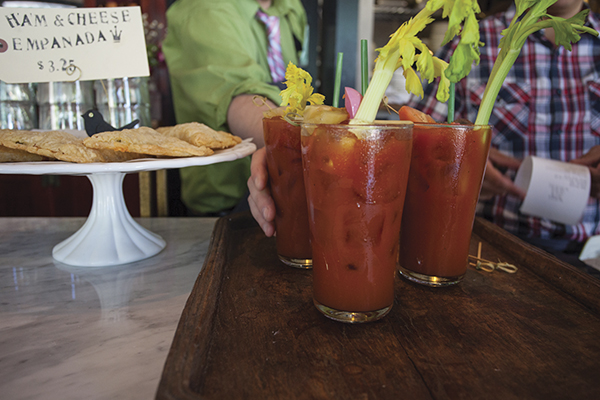
The Coronet. Photo by Andrew Brown.
12. The coronet
402 E. 9th St. (520) 222-9898, CafeCoronet.com
Another Newbie: Freshly open at the north end of the Fourth Ave. underpass in the Coronado Hotel, The Coronet feels like a Parisian cafe, complete with a lively intersection of pedestrians and traffic.
The Ambiance: It’s so new that everyone there is on their first visit. The 1906 Victorian bar is charming and the patio competes with some of Tucson’s best. Lots of shade and the Fourth Avenue passersby are sure to entertain.
The Food: Homemade, brasserie style, old-world rustic cuisine.
Hit It Up: Saturday and Sunday brunch starts at 8am. Since it’s new, there could be a wait.
Not to be Forgotten
The list of 12 is certainly not all-inclusive of great brunch spots. There is no shortage of fine eateries in Tucson for a great repast!
Arizona Inn 2200 E. Elm St. (520) 325-1541
Beautiful, historic setting and elegant, sumptuous dining.
Cushing Street Bar & Restaurant 198 W. Cushing St, (520) 622-7984
Excellent brunch cocktails paired with american and southwestern breakfast staples.
Chaffin’s Family Restaurant 902 E. Broadway Blvd. (520) 882-7707
The best Monte Cristo Sandwich in town.
The Blue Willow 2616 N. Campbell Ave. , (520) 327-7577
Many vegetarian options and great pastries. Super fun gift shop.
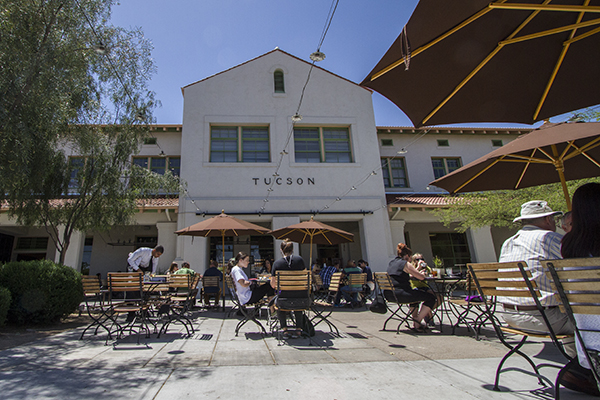
Maynards Market & Kitchen.
Maynard’s Market and Kitchen 400 N. Toole Ave. (520) 545-0577
Red Velvet Pancakes!
Hub Restaurant & Ice Creamery 266 E. Congress St. (520) 207-8201
We all scream for ice cream!
Cafe Passe 415 N. 4th Ave. (520) 624-4411
Calming, shady patio and to-die-for Chia Pudding Brulee.
Azul Restaurant and Lounge 3800 E. Sunrise Dr. (520) 742-6000
Mediterranean inspired brunch menu in the beautiful setting of the Westin La Paloma Resort and Hotel.
Mother Hubbard’s 14 W. Grant Rd., (520) 623-7976
Gourmet traditional diner food, all made fresh and from scratch. The corn pancakes are scrumptious!
Time Market 444 E. University Blvd., (520) 622-0761
Cooked to order breakfast and lunch entrees and fantastic shopping for gourmet treats.
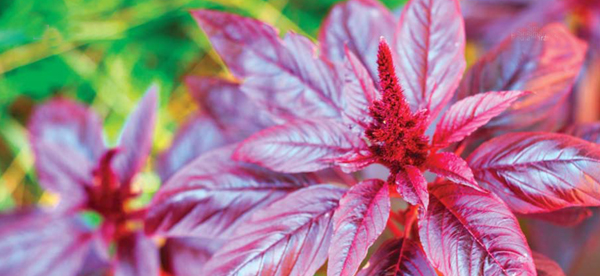


 “What kind of bar does it want to be? It was a tricky thing to determine because it has to be several different bars, depending on the circumstances,” McCrary says.
“What kind of bar does it want to be? It was a tricky thing to determine because it has to be several different bars, depending on the circumstances,” McCrary says. THE FOLLOWING ANNOUNCEMENT comes directly from Heirloom Farmers Market…
THE FOLLOWING ANNOUNCEMENT comes directly from Heirloom Farmers Market…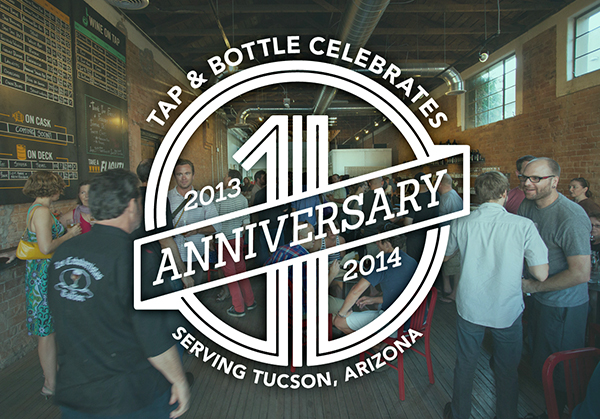 Wow! It’s already been a year.
Wow! It’s already been a year.














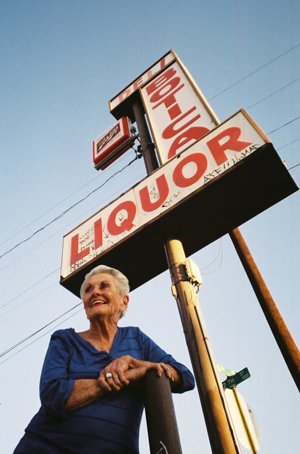




Also find us on...